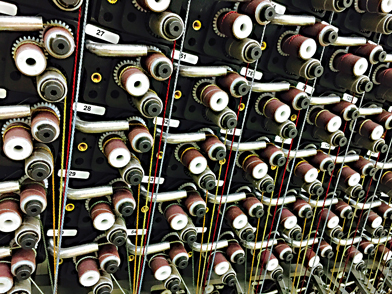The evolution of carpet design follows servo drive evolution
By Ennis O'Neil
Key Innovation: Tufting Servo Drive
Core Contributors: Tuftco, CMC, Tapistron
In the early days of tufting, variations in where the tufting needle placed the yarn were controlled with cams and chain drives.
Over time, servo drives were added and continued to evolve, allowing for more elaborate and precise patterns. This initial use of the servo in tufting was used to shift the needle bar.
The graphics machine, introduced in the late 1970s, used shifting needle bars to create patterns. Until the development of servo shift, the needle bar was moved with cams and hydraulics. The servo step was more precise than either, which made patterns more precise.
Another type of pattern machine was the scroll pattern. Prior to servo motors, the pattern was created using clutch driven rollers that created up to three pile heights through which patterns were created by burying one end under another. Initial machines operated with 12” to 36” pattern repeats. Unlike graphics machines, patterns were not limited to small scale geometrics.
In 1991, servo motors were added to replace the clutches on scroll tufting machines. Instead of three pile heights, the direct drive servo motors allowed any number of pile heights. Designs could be more precise and have smaller pattern elements compared to the scroll machine. The faster reaction time of the servo motors took a lot of looseness out of the patterns.
In 1992, Tapistron developed a CYP machine designed to make large scale patterns. These machines ran slowly but were able to make woven looking patterns using a tufting process. Scroll motors were used to control the yarn placement. Capable of six component colors but not able to create the design detail of woven, Tapistron products filled a niche between printed and woven carpet.
Designers soon felt limited by the smaller repeats in tufted carpet and wanted to increase the scale. In the early 2000s, both Tuftco and CMC introduced full repeat servo pattern machines, giving designers ultimate flexibility in terms of scale.
Also the early 2000s, carpet tile started to increase marketshare. Instead of making a carpet tile that looked like broadloom when installed, designers began making more definite patterns. Tufting machines configured with 1/8” to 1/4” needlebars with a full repeat (6’ for tile) servo pattern attachment on the 1/4” needlebar became the dominant tile machine. This allowed designers to create tile products that seemingly had no duplicate tiles.
In 2009, CMC introduced the ColorPoint machine, which utilizes the full repeat servo pattern attachment along with a servo needlebar step that shifts sideways and forward. Using CAD software, designers can create patterns with design elements as small as one stitch. Carpet designers now have ultimate design flexibility. In some hospitality applications designs 12’ wide and 90’ long have been created and installed.
Copyright 2015 Floor Focus
Related Topics:Tuftco
